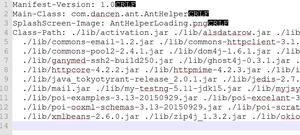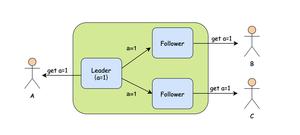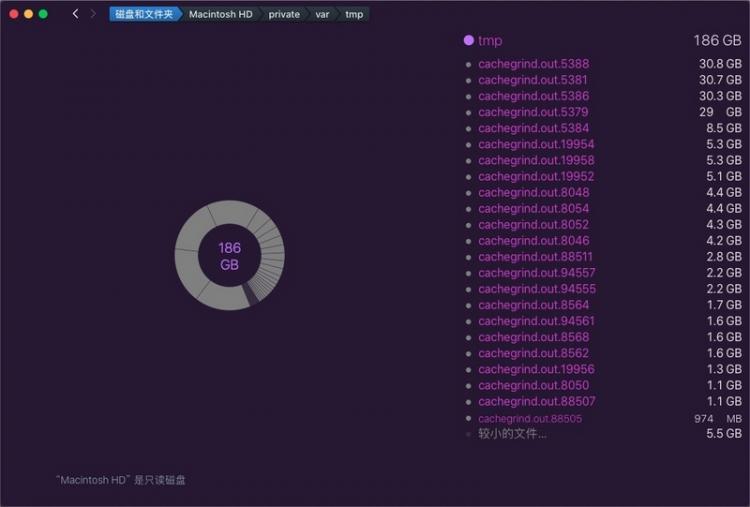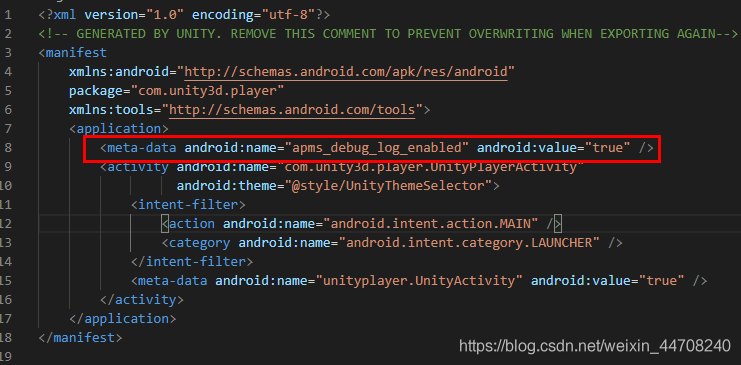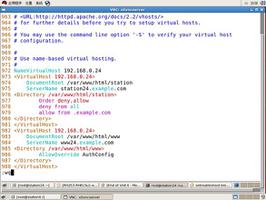【java】FileChannel 和 MappedByteBuffer 实现上有什么不同?为什么性能差这么多?
环境
mac 10.14
2.2 GHz Intel Core i7
APPLE SSD AP0512M (底下有小伙伴测出相反的结果,跟硬盘有关系)
问题描述
看RocketMQ源码的时候看到数据写到MappedFile有两种方式:
- 先写入 writeBuffer, 再将writeBuffer 写入到 FileChannel 再调用 force()刷盘;
- 数据直接写入MappedByteBuffer, 调用force() 刷盘;
我的问题是为什么不直接采用第二种方法?于是我通过下面的代码验证两种方式的写性能。
相关代码
import java.io.*;import java.nio.ByteBuffer;
import java.nio.MappedByteBuffer;
import java.nio.channels.FileChannel;
public class MMapTest {
static File file= new File("./test.txt");
static ByteBuffer buffer;
static int fileSize = 8 * 1024 * 1024;
static boolean del = true;
public static void main(String[] args) {
init(1);
deleteFile();
int[] sizes = {128,256,512,4096,8192,1024*16,1024*32,1024*128,1024*512};
try {
for (int size : sizes) {
testDBChannel(size);
testMappedByteBuffer(size);
System.out.println();
}
} catch (IOException e) {
e.printStackTrace();
}
}
private static void init(int size) {
buffer = ByteBuffer.allocateDirect(size);
}
private static void deleteFile() {
file.delete();
}
private static void testDBChannel(int size) throws IOException {
init(size);
RandomAccessFile rw = new RandomAccessFile(file, "rw");
FileChannel channel = rw.getChannel();
int writeSize = 0;
Long start = System.currentTimeMillis();
while (writeSize < fileSize) {
buffer.clear();
buffer.put(new byte[size]);
buffer.flip();
channel.position(writeSize);
channel.write(buffer);
channel.force(false);
writeSize += size;
}
//channel.force(false);
System.out.println("DirectBuffer + FileChannel write " + size + " bytes every time cost: " + (System.currentTimeMillis() - start) + "ms");
if(del)
deleteFile();
}
private static void testMappedByteBuffer(int size) throws IOException {
init(size);
RandomAccessFile rw = new RandomAccessFile(file, "rw");
FileChannel channel = rw.getChannel();
MappedByteBuffer map = channel.map(FileChannel.MapMode.READ_WRITE, 0, fileSize);
int writeSize = 0;
Long start = System.currentTimeMillis();
while (writeSize < fileSize) {
map.put(new byte[size]);
map.force();
writeSize += size;
}
//map.force();
System.out.println("MappedByteBuffer write " + size + " bytes every time cost: " + (System.currentTimeMillis() - start) + "ms");
if(del)
deleteFile();
}
}
输出:
DirectBuffer + FileChannel write 128 bytes every time cost: 3577msMappedByteBuffer write 128 bytes every time cost: 13518ms
DirectBuffer + FileChannel write 256 bytes every time cost: 1968ms
MappedByteBuffer write 256 bytes every time cost: 7044ms
DirectBuffer + FileChannel write 512 bytes every time cost: 1001ms
MappedByteBuffer write 512 bytes every time cost: 3037ms
DirectBuffer + FileChannel write 1024 bytes every time cost: 659ms
MappedByteBuffer write 1024 bytes every time cost: 1274ms
DirectBuffer + FileChannel write 4096 bytes every time cost: 214ms
MappedByteBuffer write 4096 bytes every time cost: 331ms
DirectBuffer + FileChannel write 8192 bytes every time cost: 137ms
MappedByteBuffer write 8192 bytes every time cost: 168ms
DirectBuffer + FileChannel write 16384 bytes every time cost: 77ms
MappedByteBuffer write 16384 bytes every time cost: 86ms
DirectBuffer + FileChannel write 32768 bytes every time cost: 44ms
MappedByteBuffer write 32768 bytes every time cost: 58ms
DirectBuffer + FileChannel write 131072 bytes every time cost: 16ms
MappedByteBuffer write 131072 bytes every time cost: 25ms
DirectBuffer + FileChannel write 524288 bytes every time cost: 10ms
MappedByteBuffer write 524288 bytes every time cost: 21ms
我的理解是两种方式都都是将数据写入到pageCache中再刷盘的,为什么耗时差这么多,具体两种方式的实现原理是什么?
一般情况下使用RocketMQ 都是异步刷盘,会利用OS的pageCache机制达到很高的性能;上面描述的这个问题是针对同步刷盘情况,按照 @Tyrael 第一种测试,SATA盘情况下,mbb 的性能 是要高于 db+fc 的,更加让我怀疑为什么不直接用mbb。
回答
MappedByteBuffer
在写盘时会自己创建一个DirectBuffer暂存的。因为写盘时操作系统要求传递的内存地址不能变,但是java堆管理在gc中可能把数据搬来搬去,所以需要一个堆外的DirectBuffer来存临时数据。相比直接DirectBuffer操作,是增加了一步的。
以上是看错了问题。
我测试了三种情况,macpro 14mid,阿里云ecs,macpro18。从测试情况上看应该是跟系统硬件,系统本身有关系。但是没有什么规律的样子
2019-01-15更新
这几天参阅了大量资料,总结了一个应该是正确答案的答案:
关于java8下,linux与mac得到的结果不同的解答,
FileChannel的force方法与MappedByteBuffer的force方法,最终调用的是系统中的fsync与msync方法。
- mac中,fsync方法明确说明了该方法不一定强制写盘(man page里也没有明确说写到哪了,我认为应该是写到了kernel自己的缓存里,此时fsync就返回成功了,然后kernel再缓慢的写盘 可以参考这篇文章中间的关于macos下的说明),但是同时提供了一个
F_FULLFSYNC fcntl来进行强制写盘操作,msync没有说明,可以认为是强制写盘。 - linux中, fsync方法明确说明了该方法只有写盘后才返回否则一直阻塞。这跟msync其实是类似的效果了。也有人说这种情况下,msync类似于fsync。这也是我在评论里有一个耗时差不多的情况的原因。但是从理论上,msync应该快于fsync,我怀疑是测试代码并没有达到fsync的瓶颈。
关于java11下FileChannel慢的要死的问题,
这里我发现其实是FileChannel#write()方法拖慢了节奏,尝试着找了一下java8与java11在c下的write0方法的实现,看write0()代码上都是一样的,所以也没找出具体原因。怀疑可能跟write0调用的write方法有区别。
总结。
jni的效率其实跟系统强关联,不同系统实现不同,可能会导致不同的结果,所以评论中的问题关于要用哪个,我建议是,在实际的机器环境上写测试脚本测试一下,哪个符合你的需求,就用哪个。然后以后的机器环境做统一。
RocketMQ 异步刷盘之所以提供DirectBuffer + FileChannel,主要是未了解决pageCache读写并发的问题,参考: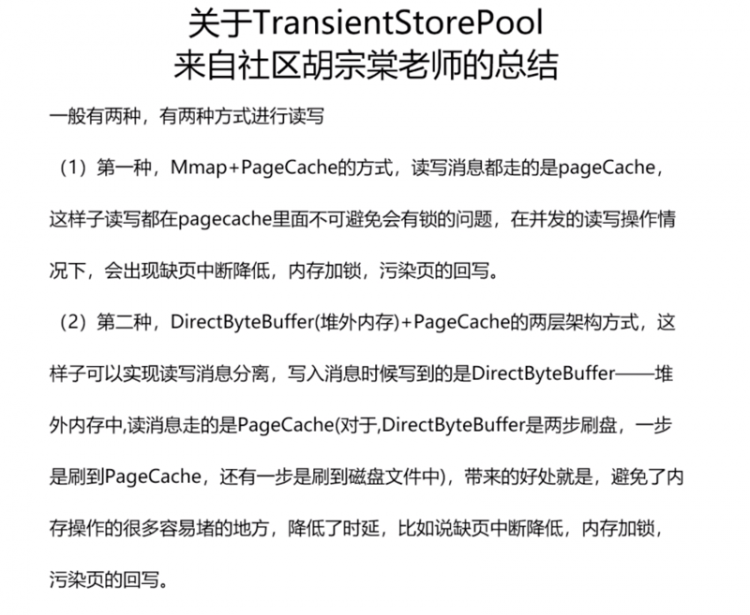
以上是 【java】FileChannel 和 MappedByteBuffer 实现上有什么不同?为什么性能差这么多? 的全部内容, 来源链接: utcz.com/a/75297.html


